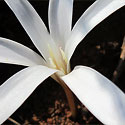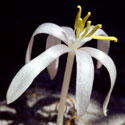|
Genus: Apodolirion
Life
> eukaryotes >
Archaeoplastida >
Chloroplastida
>
Charophyta > Streptophytina > Plantae (land plants)
> Tracheophyta (vascular plants) > Euphyllophyta > Lignophyta (woody plants)
> Spermatophyta (seed plants) > Angiospermae (flowering
plants)
> Monocotyledons > Order: Asparagales
> Family: Amaryllidaceae
Six species, all endemic to southern
Africa. Very similar in appearance to Gethyllis,
the difference lying in the attachment of the anthers. These are
bulbous plants that produce a single short-lived tubular flower typically during
late summer when it is very hot. The ovary of the flower lies below the ground,
which is believed to give it protection in the summer heat (Manning et al.
2002). It swells into a succulent berry but it seems to be unknown as to the
disperal agent(s) of these fruit. In most species, the leaves are absent or
dried up at the time of flowering. Nothing seems to be known about pollination
in this genus but the tubular, fragrant flowers suggest pollination by moths.
Species native to southern Africa
List from
Plants
of Southern Africa - an Online Checklist (SANBI).
|
Apodolirion amyanum
Occurs in the Eastern Cape, South Africa. |
|
|
Apodolirion bolusii Occurs in
the Eastern Cape, South Africa. |
|
|
Apodolirion buchananii (Natal
crocus) Recorded from South Africa (Eastern Cape, Free
State, KwaZulu-Natal, Mpumalanga) and Swaziland. Found scattered in
grassland; blooms after fire. |
 |
|
Apodolirion cedarbergense
Distribution is limited to the northern Cedarberg Mountains, Western
Cape, South Africa, where it is found on sandy flats and slopes. |
 |
|
Apodolirion lanceolatum
Recorded from Ladismith, Oudtshoorn, Still Bay and Swellendam, all in
the Western Cape, South Africa. Grows on south-facing slopes among rocks |
|
|
Apodolirion macowanii
Recorded from the Eastern Cape, South Africa, where it grows on sandy
flats. |
|
Publications
Text by Hamish Robertson |
